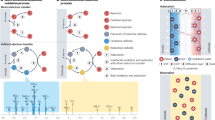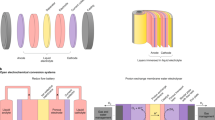Abstract
THE possibility of using fluidized bed electrodes for simplifying engineering problems encountered in scaling up electrochemical processes from a laboratory to a plant scale has been the subject of recent articles1. Back-hurst2, together with Fleischmann and Goodridge3, has proposed the use of fluidized bed electrodes for chemical syntheses. These electrodes consist of a bed of solid, electrically conducting particles supported on a sintered or porous base through which an electrolyte can be pumped. The flowing electrolyte causes the bed to expand so that the electrolyte flows smoothly between the particles. Electrical contact to the bed is made by an inert conducting wire, plate or mesh, which may be called the feeder and which is inserted into the bed.
This is a preview of subscription content, access via your institution
Access options
Subscribe to this journal
Receive 51 print issues and online access
$199.00 per year
only $3.90 per issue
Buy this article
- Purchase on Springer Link
- Instant access to full article PDF
Prices may be subject to local taxes which are calculated during checkout
Similar content being viewed by others
References
New Scientist, 37, 303 (1968).
Backhurst, J. M., thesis, Univ. Newcastle upon Tyne (1967).
British Patent Application 23070/66.
Author information
Authors and Affiliations
Rights and permissions
About this article
Cite this article
HIDDLESTON, J., DOUGLAS, A. Fluidized Bed Electrodes—Fundamental Measurements and Implications. Nature 218, 601–602 (1968). https://doi.org/10.1038/218601a0
Received:
Published:
Issue Date:
DOI: https://doi.org/10.1038/218601a0
This article is cited by
-
Bed electrodes in microbial electrochemistry: setup, operation and characterization
ChemTexts (2019)
-
The fluidized bed electrode for the continuous recovery of metals
Journal of Applied Electrochemistry (1980)
-
Experimental study of copper deposition in a fluidized bed electrode
Journal of Applied Electrochemistry (1977)
-
Fluidized bed electrodes Part IV. Electrodeposition of copper in a fluidized bed of copper-coated spheres
Journal of Applied Electrochemistry (1971)
-
Fluidized Bed Fuel Cell Electrodes
Nature (1969)
Comments
By submitting a comment you agree to abide by our Terms and Community Guidelines. If you find something abusive or that does not comply with our terms or guidelines please flag it as inappropriate.



